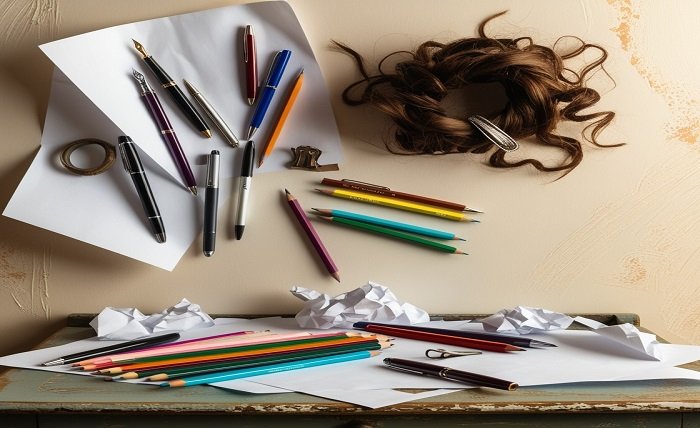We’ll go deeply into the intriguing realm of writing utensils in this extensive guide. We’ll go over everything you need to know to select the ideal tool for your requirements, from their historical development to the range of varieties currently on the market. As we go along, we’ll examine the various kinds of writing utensils, how to choose the ideal one for a certain task, and even some pointers on how to take care of your pens and pencils. You’ll be prepared to select and employ writing tools that improve your writing and creative endeavors by the time you finish reading this post.
The History of Writing Utensils
The oldest means of communication are where the history of writing utensils starts. Marks were first engraved by humans on clay, stone, and other materials. Prior to the invention of reed pens and brushes, ancient societies created written documents using crude implements like chisels.
Ancient Tools: In Mesopotamia and Egypt, the first writing utensils were sticks and pointed reeds that were used to write or carve on clay tablets. These crude instruments were frequently dipped in dye or ink.
Quills and Feather Pens: Throughout the Middle Ages, quills composed of feathers were the preferred writing utensils in Europe. For centuries, they were employed to write on parchment, which was the forerunner of paper.
The Components of a Writing Instrument
You can have a better understanding of how writing utensils work and why particular designs are more effective for particular uses by being aware of their anatomy.
Pen Body (Barrel): A writing instrument’s outer shell, usually composed of wood, metal, or plastic. By offering comfort and grip, it fulfills both an aesthetic and practical purpose.
The portion: of the pen, pencil, or marker that makes direct contact with the writing surface is called the nib or tip. The writing experience is influenced by its size, shape, and material.
Ink container: Ink is stored in the ink container. While ballpoint and gel pens frequently use disposable ink cartridges or refillable tubes, fountain pens may have refillable cartridges.
Types of Writing Utensils
There are numerous varieties of writing utensils, each with special qualities and benefits of its own. An outline of some of the most popular choices is provided below:
Ballpoint Pens
One of the most widely used and adaptable writing utensils is the ballpoint pen. As you write, ink is released onto the page via tiny ball bearings that spin in the nib. Ballpoints are renowned for their long-lasting, smooth writing and ink that dries quickly. For routine writing duties like taking notes or signing documents, they are ideal.
Fountain Pens
Fountain pens create a fluid and expressive writing utensils by combining liquid ink with a nib. Fountain pens are valued for their exquisite appearance and the rich, flowing writing they produce, even though they require more upkeep than ballpoint pens.
Selecting the Appropriate Writing Instrument for Your Assignment
The ideal tool for each occasion differs, and not all writing projects are made equal. The most typical jobs and the writing instruments that work best for them are broken down here:
For Daily Writing: For routine writing tasks like taking notes or completing forms, a dependable ballpoint or gel pen is frequently the ideal option. Both are comfortable to use for prolonged periods of time and dry quickly.
For Creative Writing: Because fountain pens and gel pens offer a smooth and expressive writing experience, writers frequently like them. Additionally, gel pens have vivid ink colors, which makes them perfect for creative writing, journaling, and sketching.
Supplies for Writing Utensils
The performance, appearance, and cost of writing utensils can all be influenced by the materials used in their manufacture. Here are a few examples of frequently used materials:
Plastic: Due to its affordability and adaptability, plastic is used to make the majority of disposable pens and pencils. High-quality plastic can still feel durable and smooth, though.
Metal: The barrel and nib of many expensive pens, especially fountain pens, are made of metals like brass, stainless steel, or gold. Metal pens tend to feel more opulent and heavier.
Wood: For individuals who favor environmentally responsible items, wooden pencils are a timeless option. High-end pen brands also frequently use wood as its material.
Conclusion
Despite their seeming simplicity, writing utensils have a long history and a big influence on our day-to-day activities. These instruments have changed over generations to accommodate our various demands, from the simple pencil to the intricate fountain pen. Selecting the appropriate writing instrument can enhance your writing experience and help you produce better work, regardless of your background—student, professional, or artist. You may choose wisely and improve your writing by being aware of the various kinds of writing implements, their components, and their intended applications.
FAQ
Which writing instrument is ideal for left-handed people?
Gel pens and rollerball pens are popular among left-handed individuals because of their smooth, fast-drying ink. In order to prevent smudging, some lefties also like fountain pens with a fine nib.
What are some ways to keep my fountain pen from drying out?
Always store your fountain pen with the cap on and avoid leaving it exposed to air for long periods. To keep the pen in good working order, wipe the nib and refill the ink reservoir on a regular basis.
What kind of pen is ideal for daily use?
A ballpoint pen’s clean writing, durability, and fast-drying ink make it perfect for daily usage. In comparison to gel pens, it is also less likely to smudge. Find out more information: movie ming

